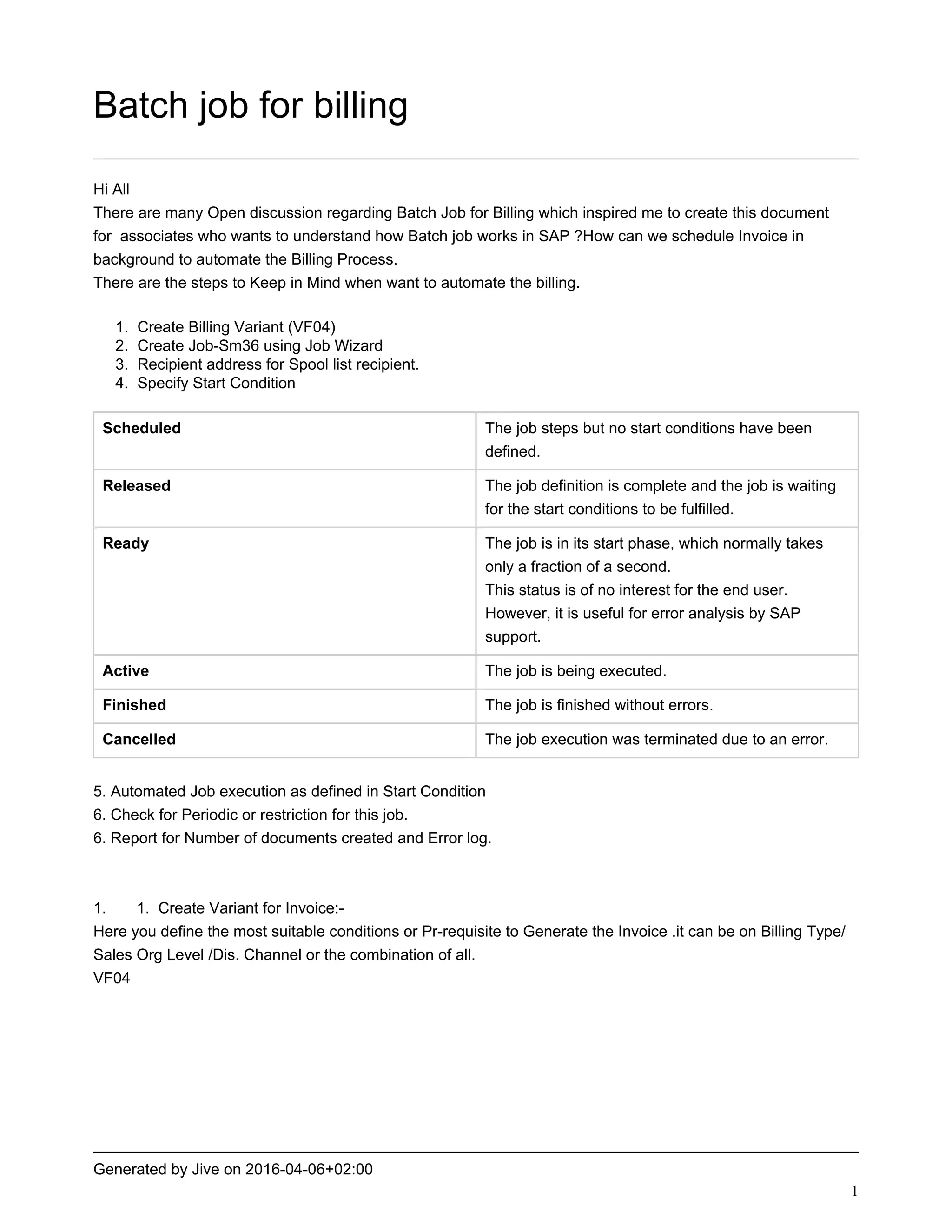Hey there, tech enthusiasts! If you're diving into the world of IoT and remote computing, you’ve probably come across the term "remoteiot batch job example remote." Now, don’t let that long phrase intimidate you. It’s actually a pretty cool concept that can revolutionize how you handle data processing and automation. In this article, we’ll break it down for you step by step, so you can understand what it means, how it works, and why it matters. Stick around, because this is gonna be a fun ride.
Before we dive deep, let’s get one thing straight: remote IoT batch jobs are not just for the tech wizards. Whether you’re a beginner or an experienced developer, this guide will help you wrap your head around the concept. By the end of this article, you’ll have a solid understanding of how remote IoT batch jobs work and how they can benefit your projects.
So, without further ado, let’s kick things off with the basics. What exactly is a remoteiot batch job example remote? Think of it as a powerful tool that allows you to process large amounts of data efficiently, without needing to be physically present. It’s like having a virtual assistant that handles all the heavy lifting for you. Now, doesn’t that sound awesome?
- Jordan Spieths Net Worth 2025 The Millions He Made Details
- How Rich Tracy Morgans Net Worth Career Life Facts
What is RemoteIoT Batch Job Example Remote?
Let’s start with the fundamentals. A remote IoT batch job is essentially a set of instructions or tasks that are executed in bulk on an IoT-enabled system. These jobs are designed to handle repetitive and time-consuming processes, freeing up your time to focus on more important tasks. And the best part? You can run these jobs remotely, from anywhere in the world.
For example, imagine you have a network of IoT devices collecting data from various sensors. Instead of manually processing each piece of data, you can set up a batch job to handle it all at once. This not only saves time but also increases efficiency and accuracy. Now, who wouldn’t want that, right?
How Does It Work?
Here’s a quick breakdown of how remote IoT batch jobs work:
- Sackler Family Net Worth Opioid Crisis Fortune 2025 Update
- Ncis Season 22 Empty Nest Premiere What To Expect More
- Data Collection: IoT devices gather data from sensors and other sources.
- Data Transmission: The collected data is transmitted to a central server or cloud platform.
- Batch Processing: The server processes the data in batches, following the predefined instructions.
- Result Generation: Once the processing is complete, the results are generated and sent back to the user or stored for future use.
This entire process happens seamlessly, without requiring constant human intervention. It’s like having a well-oiled machine that runs on autopilot.
Why Should You Care About RemoteIoT Batch Jobs?
Now that you know what remote IoT batch jobs are, let’s talk about why they matter. In today’s fast-paced world, efficiency is key. Remote IoT batch jobs offer several advantages that make them indispensable for businesses and individuals alike.
Efficiency and Automation
One of the biggest benefits of remote IoT batch jobs is their ability to automate repetitive tasks. By setting up a batch job, you can eliminate the need for manual intervention, reducing the risk of errors and saving valuable time. This is particularly useful for large-scale operations where processing data manually would be impractical.
Scalability
Another great thing about remote IoT batch jobs is their scalability. Whether you’re dealing with a small network of devices or a massive IoT ecosystem, batch jobs can handle it all. You can easily adjust the parameters and settings to accommodate your specific needs, ensuring that your system grows with you.
Cost-Effectiveness
Let’s face it—time is money. By automating your data processing tasks, you can significantly reduce operational costs. Fewer man-hours mean more money in your pocket, which is always a good thing.
Getting Started with RemoteIoT Batch Job Example Remote
So, you’re convinced that remote IoT batch jobs are the way to go. But where do you start? Don’t worry; we’ve got you covered. Here’s a step-by-step guide to help you get started:
Step 1: Identify Your Needs
The first step is to identify what you want to achieve with your remote IoT batch job. Are you looking to process sensor data? Analyze customer behavior? Or maybe optimize your supply chain? Understanding your specific requirements will help you design a batch job that meets your needs.
Step 2: Set Up Your IoT Infrastructure
Next, you’ll need to set up your IoT infrastructure. This includes installing sensors, configuring devices, and establishing a reliable connection to your central server or cloud platform. Make sure everything is properly configured to ensure smooth data transmission and processing.
Step 3: Define Your Batch Job
Once your infrastructure is in place, it’s time to define your batch job. This involves specifying the tasks that need to be performed, setting up the schedule, and defining the parameters. You can use various tools and platforms to create and manage your batch jobs, depending on your preference and expertise.
Tools and Platforms for RemoteIoT Batch Job Example Remote
When it comes to implementing remote IoT batch jobs, there are several tools and platforms available that can make your life easier. Here are some of the most popular ones:
AWS IoT
AWS IoT is a powerful platform that allows you to connect and manage IoT devices at scale. It provides a wide range of features, including device management, data processing, and analytics. With AWS IoT, you can easily set up and manage your remote IoT batch jobs, ensuring seamless operation.
Microsoft Azure IoT
Microsoft Azure IoT is another great option for implementing remote IoT batch jobs. It offers a comprehensive suite of tools and services that make it easy to build, deploy, and manage IoT solutions. Whether you’re a beginner or an experienced developer, Azure IoT has something for everyone.
Google Cloud IoT
Google Cloud IoT is a cloud-based platform that provides robust tools for managing IoT devices and processing data. It integrates seamlessly with other Google Cloud services, making it a great choice for businesses looking to leverage the power of the cloud for their IoT projects.
Best Practices for RemoteIoT Batch Job Example Remote
To ensure the success of your remote IoT batch jobs, it’s important to follow some best practices. Here are a few tips to keep in mind:
- Monitor Performance: Regularly monitor the performance of your batch jobs to identify and address any issues promptly.
- Optimize Resources: Make sure you’re using your resources efficiently to avoid unnecessary costs and delays.
- Secure Your Data: Implement strong security measures to protect your data from unauthorized access and cyber threats.
By following these best practices, you can ensure that your remote IoT batch jobs run smoothly and deliver the desired results.
Challenges and Solutions in RemoteIoT Batch Job Example Remote
While remote IoT batch jobs offer numerous benefits, they also come with their own set of challenges. Here are some common challenges and how you can overcome them:
Data Overload
With so much data being generated by IoT devices, it’s easy to get overwhelmed. To tackle this, you can implement data filtering and prioritization techniques to focus on the most relevant data.
Network Connectivity Issues
Poor network connectivity can disrupt the data transmission process. To mitigate this, consider using redundant connections or offline processing capabilities to ensure uninterrupted operation.
Real-World Applications of RemoteIoT Batch Job Example Remote
Remote IoT batch jobs are being used in a variety of industries to solve real-world problems. Here are a few examples:
Smart Agriculture
In the agriculture industry, remote IoT batch jobs are used to monitor and analyze soil moisture levels, weather conditions, and crop health. This helps farmers make data-driven decisions to optimize their yield and reduce waste.
Healthcare
In healthcare, remote IoT batch jobs are used to process patient data from wearable devices, enabling doctors to monitor their patients’ health in real-time and provide timely interventions.
Conclusion: Take Your RemoteIoT Batch Job Example Remote to the Next Level
And there you have it—a comprehensive guide to remote IoT batch jobs. From understanding the basics to exploring real-world applications, we’ve covered everything you need to know to get started. So, what are you waiting for? Dive in and take your IoT projects to the next level.
Don’t forget to leave a comment below and share your thoughts on remote IoT batch jobs. And if you found this article helpful, be sure to check out our other articles for more tech insights and tips. Until next time, stay curious and keep learning!
Table of Contents
- What is RemoteIoT Batch Job Example Remote?
- How Does It Work?
- Why Should You Care About RemoteIoT Batch Jobs?
- Getting Started with RemoteIoT Batch Job Example Remote
- Tools and Platforms for RemoteIoT Batch Job Example Remote
- Best Practices for RemoteIoT Batch Job Example Remote
- Challenges and Solutions in RemoteIoT Batch Job Example Remote
- Real-World Applications of RemoteIoT Batch Job Example Remote
- Conclusion: Take Your RemoteIoT Batch Job Example Remote to the Next Level
- Fath Properties Cincinnati Apartments More Youll Love
- Where Are They Now The Nyc Prep Cast Today Updates


